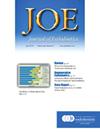Optimizing Stem Cell Expansion: The Role of Substrate Stiffness in Enhancing Dental Pulp Stem Cell Quiescence and Regeneration
IF 3.5
2区 医学
Q1 DENTISTRY, ORAL SURGERY & MEDICINE
引用次数: 0
Abstract
Introduction
Quiescent stem cells exhibit unique self-renewal and engraftment abilities vital for regenerative therapies, but these diminish during ex vivo culture. This study investigates how substrate stiffness regulates the balance between dental pulp stem cell (DPSC) quiescence, activation, and senescence and explores the role of extracellular matrix stiffness in modulating DPSC fate via the nuclear factor kappa-light-chain-enhancer of activated B cells (NF-κB) pathway.
Methods
Polydimethylsiloxane substrates with varying stiffness in 2D (2 kPa, 50 kPa) and 3D (50 kPa) were fabricated. Mechanical properties and porosity were characterized. Human DPSCs were cultured for 7 and 14 days. Senescence was assessed by senescence β-galactosidase activity, nuclear changes by immunofluorescence staining, and gene expression of quiescence, self-renewal, and senescence markers by reverse transcription quantitative polymerase chain reaction. NF-κB activation was analyzed through p65 nuclear translocation. Statistical analysis employed one-way analysis of variance with post-Tukey tests (P < .05).
Results
The porous (310 ± 63 μm) 3D substrate had 50 kPa stiffness. DPSCs on 50 kPa substrates exhibited increased nuclear size and senescence in both 2D and 3D contexts. Softer 2 kPa substrates promoted quiescence, evidenced by reduced chromatin condensation and senescence, alongside upregulation of quiescence associated genes (BMI-1) and pluripotency markers (NANOG, OCT4, SOX2). NF-κB activation was observed on soft substrates, marked by nuclear translocation of p65 and upregulated NF-κB pathway genes, correlating with enhanced stemness and reduced senescence.
Conclusions
This study highlights the pivotal role of substrate stiffness in modulating stem cell fate. Softer substrates preserve DPSC quiescence, reduce senescence, and enhance stemness through NF-κB pathway activation, offering insights into optimizing ex vivo DPSC expansion for therapeutic applications.
优化干细胞扩增:基质刚度在增强DPSC静止和再生中的作用。
静止干细胞表现出独特的自我更新和植入能力,这对再生疗法至关重要,但在体外培养过程中这些能力会减弱。本研究探讨了基质刚度如何调节牙髓干细胞(DPSC)静止、激活和衰老之间的平衡,并探讨了细胞外基质刚度通过活化B细胞(NF-κB)途径调节DPSC命运的作用。方法:制备二维(2 kPa、50 kPa)和三维(50 kPa)不同刚度的聚二甲基硅氧烷基板。表征了材料的力学性能和孔隙率。人DPSCs分别培养7天和14天。采用衰老β-半乳糖苷酶活性、免疫荧光染色法检测细胞核变化、反转录定量聚合酶链反应法检测静止、自我更新和衰老标志物的基因表达。通过p65核易位分析NF-κB活化。统计学分析采用单因素方差分析,后tukey检验(P < 0.05)。结果:多孔(310±63 μm)三维基底的刚度为50 kPa。在50kpa底物上的DPSCs在2D和3D环境下均表现出核尺寸增加和衰老。较软的2kpa底物促进了细胞的静息,表现为染色质凝聚和衰老的减少,以及静息相关基因(BMI-1)和多能性标记(NANOG, OCT4, SOX2)的上调。在软底物上观察到NF-κB活化,以p65核易位和NF-κB通路基因上调为标志,与增强干性和减少衰老相关。结论:本研究强调了底物硬度在调节干细胞命运中的关键作用。较软的底物通过激活NF-κB通路保持DPSC静止,减少衰老,增强干性,为优化体外DPSC扩增用于治疗应用提供了见解。
本文章由计算机程序翻译,如有差异,请以英文原文为准。
求助全文
约1分钟内获得全文
求助全文
来源期刊

Journal of endodontics
医学-牙科与口腔外科
CiteScore
8.80
自引率
9.50%
发文量
224
审稿时长
42 days
期刊介绍:
The Journal of Endodontics, the official journal of the American Association of Endodontists, publishes scientific articles, case reports and comparison studies evaluating materials and methods of pulp conservation and endodontic treatment. Endodontists and general dentists can learn about new concepts in root canal treatment and the latest advances in techniques and instrumentation in the one journal that helps them keep pace with rapid changes in this field.
 求助内容:
求助内容: 应助结果提醒方式:
应助结果提醒方式:


